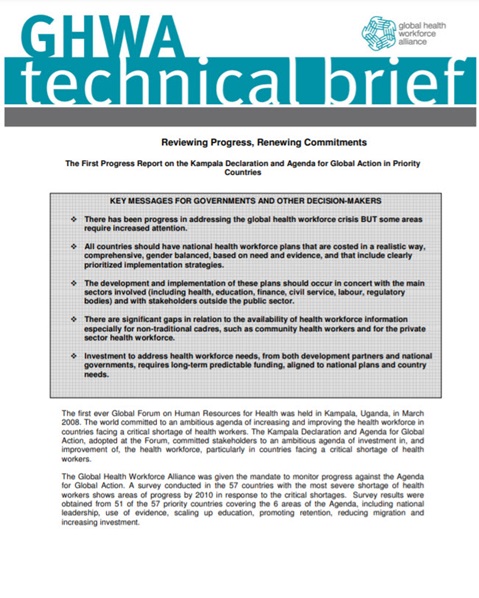Reviewing progress, renewing commitments: Progress report on the Kampala Declaration and Agenda for Global Action: Questionnaire for Monitoring and Evaluation the Implementation of the Kampala Declaration and Agenda for Global Action Questionnaire

Overview
In January 2011, the Alliance conducted a survey among the 57 priority countries to assess the extent to which they are making progress with The Kampala Declaration and Agenda for Global Action. A questionnaire was drawn up and sent to focal persons in the ministries of health in each priority country in July 2010. Forms were filled in online or by e-mail.
Nine proxy indicators were developed to track each of the strategies of the Agenda for Global Action. These include the number of countries that have developed and implemented:
- costed and evidence-based HRH plans;
- an intersectoral coordination mechanism for involving relevant stakeholders in HRH development;
- a national mechanism with processes and/or tools for HRH data users and producers to inform policy-making and management of the health workforce;
- a well-functioning HRH information system;
- programmes to increase the production of doctors, nurses/midwives and community health workers;
- strategies/approaches to attract and retain the health workforce in underserved areas;
- policies to favour in-country retention of personnel;
- increased budgetary allocations for community health workers as a proportion of the health sector budget;
- additional investment from multilateral and bilateral partners for HRH plans.
The report Reviewing progress, renewing commitments: Progress report on the Kampala Declaration and Agenda for Global Action (The Alliance, 2011) is based on analysis of the responses to the questionnaire, combined with excerpts from submitted case stories and reference to secondary literature.
A one-page country brief for each of the priority countries gives an update on their HRH status and progress. The briefs contain background demographic, health, health system and HRH statistics, as well as scores for responses to the tracking survey.
Limitations of this analysis include the absence of baseline data with which to compare the responses, the self-reported nature of the responses, and the focus on process issues and binary (yes/no) questions. The latter, for example, precludes an analysis of the quality and comprehensive nature of plans, the level of functionality of coordination mechanisms.
